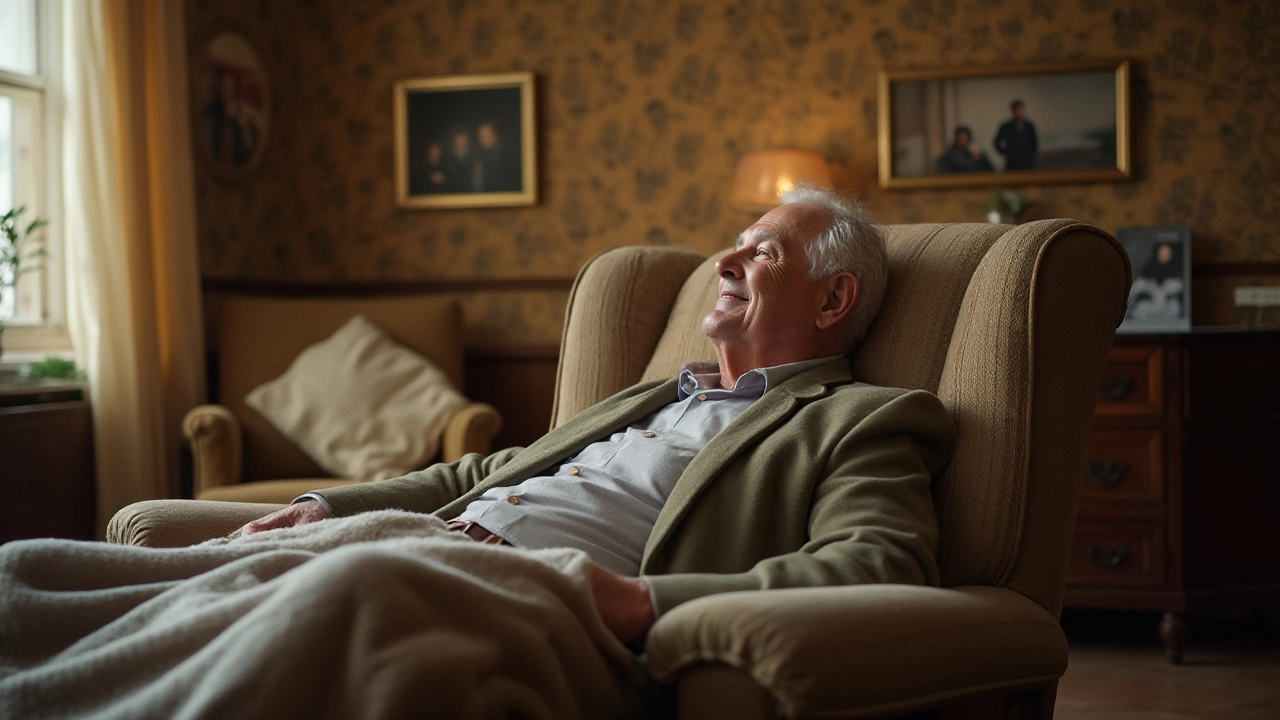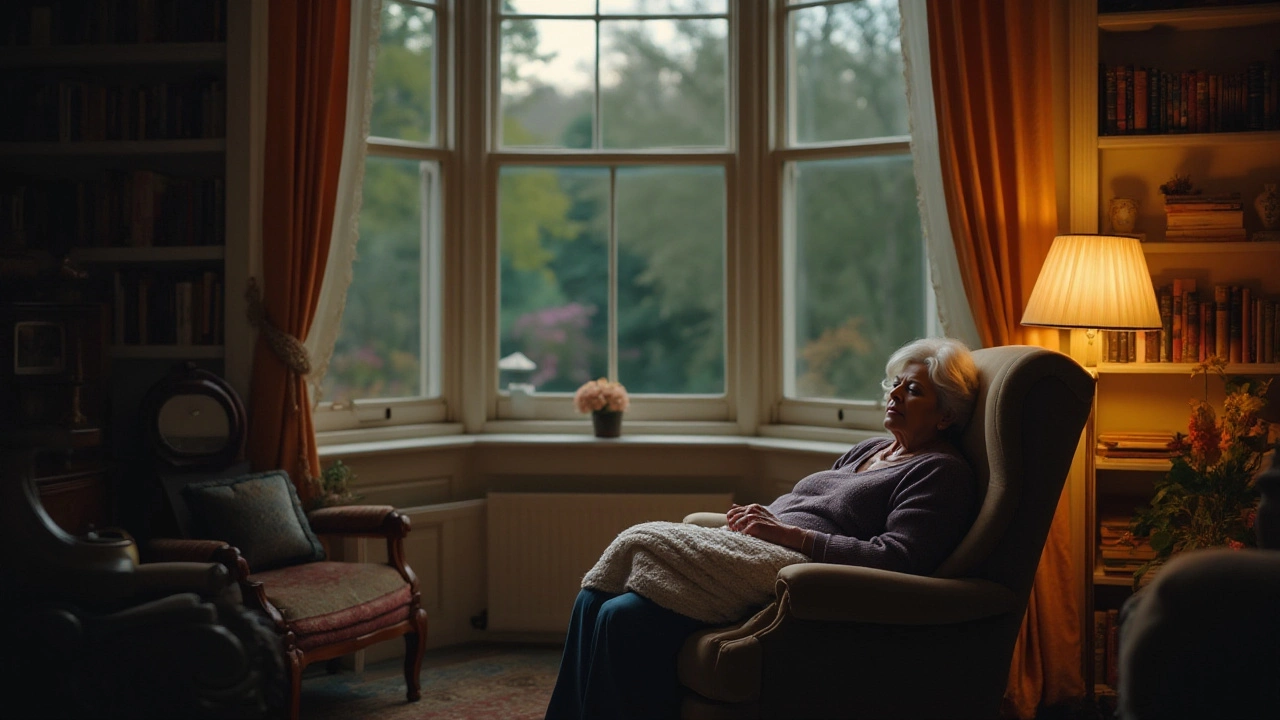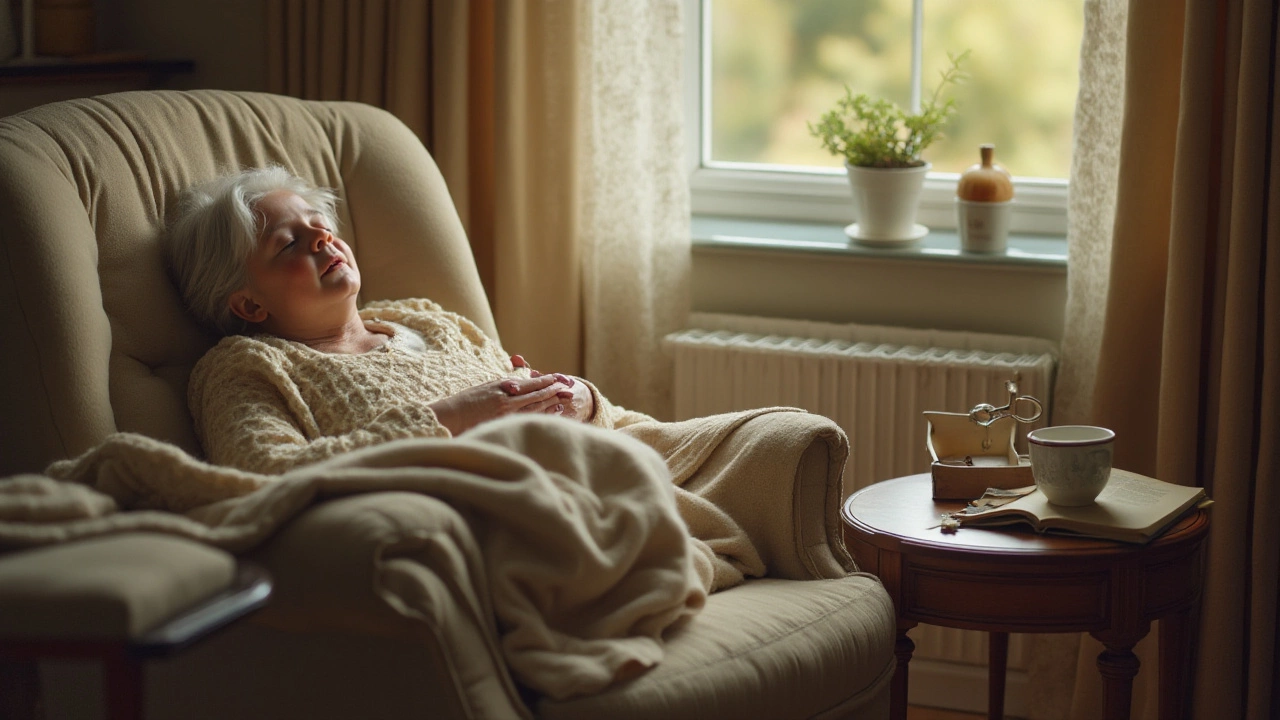Getting a good night's rest is especially crucial for seniors, impacting both their physical health and overall wellbeing. As people age, sleep patterns tend to change, often making it more challenging to achieve uninterrupted sleep. One often overlooked solution is the use of recliner chairs, which can offer a more supportive and comfortable sleeping environment.
Recliners are not just for lounging; they offer numerous benefits for senior sleep health. By choosing the right angles and positions, seniors can experience improved circulation, reduced back pain, and less strain on pressure points. This makes them an excellent alternative to traditional beds, particularly for those who may have difficulty lying flat or have specific health concerns.
- The Importance of Sleep for Seniors
- Why Recliners are Beneficial
- Choosing the Right Recliner
- Best Reclining Positions for Sleeping
- Tips for Enhancing Sleep in Recliners
The Importance of Sleep for Seniors
Sleep is a cornerstone of health, influencing how well we function and feel each day. For seniors, it plays an even more crucial role in maintaining physical health and emotional wellbeing. Sleep patterns evolve with age, which is why understanding its importance can help seniors navigate their unique challenges. While an adult typically needs around 7 to 9 hours of sleep per night, older adults often experience disruptions due to changes in the body's internal clock or conditions such as arthritis, making restful nights harder to achieve. Sleeping in the right position, whether in a traditional bed or a recliner chair, can mitigate many of these challenges.
Research has consistently shown that good sleep is linked to a lower risk of chronic conditions like heart disease and diabetes, both of which are more prevalent among seniors. Regular, high-quality sleep can help boost immune function, reduce inflammation, and even improve memory retention, which naturally declines with age. Dr. Julie K. Silver, a Harvard medical expert, once noted,
"There is a fine balance between too much and too little sleep, and finding that balance is crucial, especially as we grow older."
Interestingly, seniors often find themselves waking up earlier and experiencing more fragmented sleep. These changes can sometimes lead to both physical and cognitive impairments, affecting how they interact with their environment and react to external stimuli. A lack of sleep may contribute to increased fall risk, daytime fatigue, and a decrease in coordination. Thus, adjusting the sleep environment with alternatives like recliner chairs can offer the support and comfort needed, potentially leading to more satisfying sleep. In conclusion, recognizing and adapting to these unique sleep needs is essential for seniors to maintain their health and quality of life.
Why Recliners are Beneficial
As we move through the stages of life, comfort becomes a pivotal part of our daily experience, especially when it comes to resting and sleeping. For seniors, finding comfort is not just about plush cushions and soft pillows; it's about support, ease of use, and functionality. This is where recliner chairs come into play. Recliners have become a popular choice for older adults for a variety of reasons—most notably their ability to combine comfort with therapeutic benefits. For those who find lying flat on a traditional bed challenging, a recliner can offer a viable alternative that promotes better sleep quality. These chairs are designed to adjust to different angles, supporting the back and legs in a way that reduces pressure points and encourages muscle relaxation.
One of the strongest arguments for recliner chairs comes from their ability to improve circulation. Many seniors deal with circulatory issues, especially if they have conditions like arthritis or diabetes. Recliners can be adjusted to a position that elevates the legs above heart level, which can aid in reducing swelling in feet and legs. This position is often referred to as the zero gravity position, as it mimics the posture astronauts take during lift-off, reducing stress on the body. Not only is this position effective for circulation, but it also helps in alleviating pain in the lower back and enhancing lung capacity, which is beneficial for those with respiratory issues.
A study conducted by the Health Sleep Institute found that elevating the legs during rest can significantly improve venous return and reduce discomfort associated with chronic venous insufficiency, a common issue in the elderly population.
Beyond health benefits, recliners also score high on the scale of functionality. Many come with features like built-in massagers and heat options. These can be particularly soothing for seniors dealing with sore joints and muscles. The gentle massage provided by some recliners can promote relaxation, making it easier to drift off to sleep. Moreover, these recliners are often designed to be easy to get in and out of, which is a crucial aspect for someone who may not have the strength or agility they once did. The electric-powered models are even more user-friendly, enabling seniors to adjust positions with the press of a button.
In terms of practicality, recliners allow seniors to transition from a seated to a sleeping position without needing to move to a different location, which is particularly advantageous if mobility is an issue. For those times when getting up for a glass of water or to switch off the lights seems a task too daunting to manage, this comfort can't be understated. Family members and caregivers also find peace of mind knowing that their loved ones have a safe and comfortable place to relax and sleep. With a wide variety of styles available on the market, from classic designs to modern ones equipped with smart features, there's a recliner suitable for any senior's needs and home aesthetic.

Choosing the Right Recliner
When it comes to selecting the perfect recliner for seniors, a thoughtful approach can significantly impact comfort and sleep quality. The myriad of choices available, each boasting its unique features, can be daunting. However, honing in on a few critical aspects can simplify the decision-making process. First and foremost, size and dimensions are paramount. A recliner that's too large can leave a senior feeling unsupported, while one that's too small might feel constricting. The chair should accommodate the user's height and weight comfortably, allowing their feet to rest flat on the floor when seated upright, which promotes proper posture and reduces strain when transitioning to sleep.
Fabric selection also plays an essential role. While leather may offer durability and style, it can be less breathable, causing discomfort during warmer months. Fabrics that allow airflow and provide some form of padding can enhance comfort, especially during extended periods of use. Some recliners feature breathable mesh or plush microfiber, which can be both comfortable and stylish. Beyond material, consider ease of use. Seniors should be able to smoothly transition from sitting to reclining without exertion. Many modern recliners offer electronic controls or easy-to-use levers, which can make adjustments seamless.
Another critical factor is the mechanism itself. For seniors dealing with joint or back pain, a lift recliner, which gently assists the user to a standing position, could be invaluable. Also, there are recliners that offer a full 180-degree recline, mimicking the sleeping position of a bed. While shopping, try to pay attention to additional features such as built-in lumbar support, which can greatly alleviate back strain. Some models even include therapeutic heat or massage functions, adding an additional layer of relaxation and potentially improving circulation.
Safety cannot be overstated. Recliners should offer a solid, stable base to prevent tipping. Over time, regular use can loosen parts, so it's worth considering models that boast robust construction and warranties that guarantee longevity. Look for chairs that have passed safety standards, ensuring that they provide the stability and support seniors require. Speaking of stability, wider armrests can also provide added leverage, making it easier for seniors to sit down and stand up.
"The best recliner is one that combines comfort, support, and ease of use – meeting the specific needs of the elderly," notes Jennifer Blake, a senior home furnishing expert.
To wrap up, understanding the user's needs and lifestyle is vital. Are they reading, watching TV, or napping? These activities might require different features. A pocket for remote controls and magazines, cup holders, or even USB charging ports can transform a recliner from a chair to a modern-day comfort station. Remember, investing in a high-quality recliner can contribute immensely to the well-being and quality of life for seniors, turning a simple piece of furniture into an essential tool for relaxation and rest.
Best Reclining Positions for Sleeping
When it comes to finding the perfect sleep position in a recliner, comfort and health benefits walk hand in hand. Many seniors have discovered the seemingly magical benefits of dozing in these versatile chairs. Whether it is alleviating back pain, reducing pressure on joints, or supporting proper spinal alignment, recliners can offer tailored comfort that conventional beds may not. Starting with the most popular position, the semi-reclined pose can be a lifesaver. Tilting the recliner back just slightly keeps your head elevated while the body remains relaxed. This minimizes strain on the spine and is particularly helpful for those dealing with persistent upper back pain or acid reflux. By keeping the trunk elevated, the esophageal sphincter remains above the stomach acid level, reducing chances of nighttime heartburn.
The zero-gravity position, inspired by NASA's astronauts, has also gained traction in recent years. This involves reclining back further, aligning the heart, spine, and legs in harmony, creating a sensation of weightlessness. In this state, the heart does not have to work as hard, and circulation improves significantly. The reduction in gravitational pull means fewer pressure points, providing significant relief to aching joints and reducing swelling in the limbs. For those with varicose veins or edema, this can make a noticeable difference in comfort levels. A study has even shown that 75% of seniors reported reduced back pain after a month of using a zero-gravity recliner setup.
"Recliners, especially in the zero-gravity position, have proven to significantly enhance joint recovery and sleep quality in senior patients," mentions Dr. Emily Richards, a renowned geriatric specialist.
The lumbar support position is another premier choice for seniors, focusing on adding extra cushioning or framework to support the lower back. Many recliners are now designed with built-in lumbar adjustments, providing needed support to one of the most common areas of concern for seniors. By stabilizing the lower back, overall posture improves and the likelihood of developing chronic back pain decreases. Enhancing this position with a gentle neck pillow can keep the neck supported, reducing the risk of waking up with a stiff neck, something quite common when sleeping in the wrong position.
For seniors seeking a gentle transition from sitting to sleeping, the reclined sleeping position caters well to those desiring a nap or a full night’s rest. Leaning slightly back while keeping feet elevated is effective for spinal alignment and minimizes lower back pain. In this position, the pressure on the spine’s lower region is reduced, a boon for those who deal with night-time backaches. An additional tip—use cushioned armrests to support your arms and alleviate shoulder tension. A table lamp with adjustable light levels can also aid in creating a cozy, personalized environment.
For those considering surgery or recovering from it, particular postures aid healing. Positioning the head, shoulders, and knees correctly is crucial. Slightly raising the legs—either by using built-in recliner functions or a separate footrest—facilitates proper blood circulation and reduces the risk of blood clots, which is vital for recovering seniors. An individual might even rotate between the side and back postures to find which angle delivers the deepest sense of relaxation. Remember, customizing the recliner’s settings and using supplementary pillows as needed ensures that each sleep experience is as restful and restorative as possible. So next time you settle down in your recliner, experiment a little—your body may thank you for it.

Tips for Enhancing Sleep in Recliners
When it comes to improving sleep in recliner chairs, a few thoughtful adjustments can make all the difference. Ensuring that the recliner is positioned at the correct angle is crucial. Many seniors find that a slight incline helps reduce pressure on their spine and hips, which can be beneficial in alleviating aches. Recliners that allow for adjustments between 30 and 45 degrees tend to support the natural curve of the back, making them an ideal option for comfort and rest.
Beyond positioning, selecting the right recliner plays a huge role. Modern recliners offer features like heating pads and massage capabilities, which can significantly contribute to a relaxing night of sleep. These features promote muscle relaxation and can aid with circulation issues, common among seniors. Seniors sleeping positions can be enhanced by using additional cushions or pillows to provide lumbar support, which helps distribute weight more evenly and prevents any stiffness overnight.
Temperature control is another important factor that cannot be overlooked. As bodies age, they often become more sensitive to temperature fluctuations. Ensuring a stable and comfortable room temperature, along with breathable blanket choices, can be just as significant as the choice of recliner itself. A fleece blanket often offers warmth without excessive weight, making it a smart choice for many.
The Sleep Foundation notes that, "a supportive sleep environment is key to maintaining good sleep hygiene and overall wellness."
Routine is another key to maximizing the benefits of sleeping in recliners. Developing a regular sleep schedule, complete with a soothing bedtime ritual, can help signal to your body that it is time to wind down. This can be as simple as a calming herbal tea or a few moments of meditation before settling into the chair. Over time, these small practices can make sleeping in a recliner feel as natural and restorative as any other sleep environment.
In addition, it's worth considering light exposure before bedtime. Blue light from electronics can disrupt the body's natural sleep-wake cycle. To enhance the sleep experience in a recliner, limiting screen time at least an hour before bed can help improve the quality of sleep. Instead, opt for a good book or gentle music to transition into a more restful state of mind.
By integrating these tips, the advantages of recliners can be significantly amplified for seniors, turning them into not just a chair but an integral part of a healthy sleep routine. With a bit of care and consideration, these tips can transform a recliner into a sanctuary of rest and rejuvenation.



